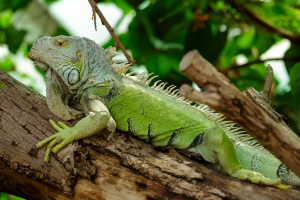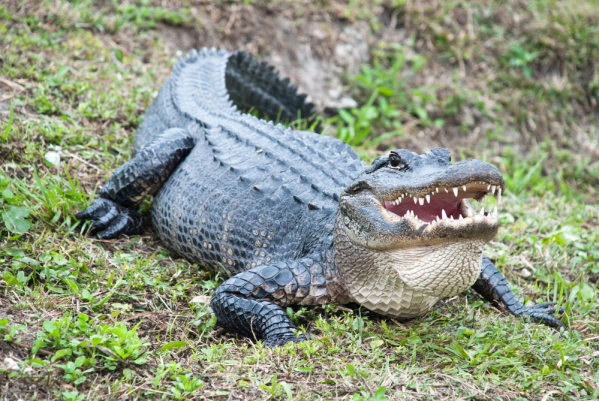Learn all there is to know about these cold-blooded creatures with these fascinating reptile facts!
Witten by: Niki Giovanis

What Exactly is a Reptile?
Reptiles can take on many forms and are diverse vertebrates, meaning they have a backbone. Their dry, scaly skin characterizes reptiles. Millions of years ago, dinosaurs roamed the earth and were some of the most outstanding examples of the earth’s largest reptilian inhabitants. Today, when we think of the major groups of living reptiles, turtles, snakes, lizards, and crocodiles should come to mind.
The Physiology of Reptiles
What separates reptiles from any other species on the planet is that reptiles do not maintain a stable inner body temperature, unlike mammals and birds. Therefore, reptiles are scientifically classified as cold-blooded creatures. Since reptiles lack fur or feathers to heat them when they are cold or sweat glands to cool them off when they are too warm, they are forced to move into the sun or shade accordingly.

How Do Reptilian Species Breathe?
Reptiles use their lungs for breathing. However, because reptilian species are so diverse, each group has adapted to breathing in different ways. Most reptiles lack a secondary palate except for crocodiles, which means they must hold their breath when they swallow. This bony secondary palate also allows crocodiles to continue breathing when they are underwater. Simultaneously, the palate protects their brains from any damage that may be caused by struggling prey or when they are fighting off danger.
Since most turtle shells are incredibly rigid, they cannot expand and contract as you would see in other kinds of reptiles. Therefore, some turtles have evolved to have a sheet of muscle that contracts when they exhale. They can also retract the muscle into their body cavity to force the air out of their lungs.
Reproduction
Except for pythons and boas, all other reptilian species lay eggs in a nest and return when the eggs are ready to hatch. The eggs need to stay dry so that many reptiles will bury the eggs in soil or sand. Interestingly enough, some snakes, such as mud snakes, will wrap their bodies around the eggs to protect them from any harm. Alligator mothers, on the other hand, will carry their newly hatched babies in their mouths!
Temperature-Dependent Sex Determination
Some reptile species, such as turtles and crocodiles, display a temperature-dependent sex determination (TDSD). This means that the temperature of the egg determines the sex of the babies. For example, warmer egg temperatures produce females for some turtles, cooler temperatures result in males, and temperatures in the middle will create a combination of genders. On the other hand, with crocodiles, cooler temperatures will result in females, while warmer temperatures will result in male offspring.
Skin
Reptiles have a dry, scaly layer of skin that is often covered in a horny epidermis that allows them to live on land instead of water. Unlike mammals, reptiles lack a thick dermal layer, which causes their skin to be fragile. On the other hand, exposed patches on snakes are protected by scales and a bony base that forms a type of armor.
Shedding
Due to their skin being so thin, reptiles shed through a process called ecdysis, which occurs continuously throughout their lifetime. While younger reptiles tend to shed once every 5 to 6 weeks, adults shed 3 to 4 times a year. Younger reptiles shed more due to their rapid growth rate; once they become full size, the regularity of shedding slows down.
The method of ecdysis results in forming a new layer of skin under the old one. Lymphatic fluid is produced between the old and new layers of skin, which hoists the old and new layers apart, causing the reptile to shed.
Food and Digestion
id you know that most reptiles eat insects and meat? digestion in reptiles occurs slower than in mammals. Reptiles also possess the ability to break down meat easier. Interestingly enough, the jaw structure of a reptile does not allow them to chew their food; they can only tear it! Some reptilian species swallow rocks to help with their digestion as the rocks aid in grinding up the vegetation.
Defense Tactics
Snakes and lizards are highly susceptible to being preyed on by all kinds of animals. There are two types of reptile predators: birds and other reptiles. Therefore, avoidance is their most common type of defense mechanism.
Camouflage
Reptiles tend to avoid confrontation through camouflage. Many reptiles have a mixture of green, gray, and brown color that allows them to blend into the background of their natural environment. Reptiles also can remain motionless for long periods, which also aids in their camouflage efforts. If danger arises, reptilian species such as turtles, snakes, and crocodiles will hiss loudly to confront their enemy. Rattlesnakes, on the other hand, will vibrate the tip of their tail.

Defense in Snakes
Through evolution, the snake species have adopted various defensive tactics. They also use an intricate set of behaviors when attacked. Some snakes will raise their head and spread the skin behind their neck to look large and threatening to the other animal. If this does not work, snakes such as vipers or cobras will use their venom to attack as a last resort.

Crocodile Defense Mechanisms
The first line of defense in the crocodilian species is to expose their large teeth to come off as intimidating against their predators. Their next form of protection is to begin making a hissing sound and inflate their bodies to increase their size –making them appear more intimidating. However, the cardinal weapon of defense in all crocodilian species is their high force bite.
Lizard Escape Plan
In some instances of survival, lizards can remove their tail if a predator grabs onto it. The broken tail will continue to move and confuses the predator. This ultimately allows the lizard enough time to escape from the situation. Luckily, some lizards can grow a new tail in place of the old one. However, it is usually shorter and sometimes a different color than their original tail.
Reptiles are Intelligent Creatures
Although their brains’ size is smaller than that of mammals, they’re smarter than we may think! Reptiles can decipher complex problems, can remember what they have learned. They also share the same intelligence level as birds and mammals. Reptiles also possess advanced social skills and flexible behavior adaptable to specific situations such as recognizing their family and caring for their children. They also exhibit instances of social learning, play behavior, and cooperation!
More Quick Reptilian Facts
Want to know more about the reptilian species? Stick around for these last quick reptilian facts!
Did you know that over 8,000 different reptiles on the planet live on every continent except Antarctica, where it’s too cold for them to survive? That’s a lot of species! Further, reptiles are among the longest-lived species on the earth. While alligators can live to be 70 years old, the Aldabra Tortoise can live to be more than 150 years old!
The longest reptile on the planet is the Reticulated Python(Malayopython reticulatus); Reticulated Pythons can reach lengths of up to 10 meters(32.8 feet) long. In comparison, the smallest reptile is the Nano-Chameleon(Brookesia nana); it is between 2.2 and 2.9 cm(0.87 to 1.1 inches).
Although it may come as a surprise, the Green Sea Turtle(Chelonia mydas) is the fastest reptile of all and can reach up to 35 kilometers(21.7 miles) per hour!
Niki Giovanis is a freelance writer who does not necessarily share the opinions expressed on BrantaMedia.com.
